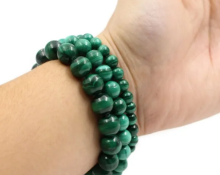
Amethyst is a type of quartz and is composed of silicon dioxide. The purple color of this gemstone is due to the impurities present in its crystal structure.
Amethyst has a hardness rating of 7 out of 10 on the Mohs scale, so the stone is relatively hard, although harder gemstones such as diamond or sapphire may scratch it.
Amethyst color rating
The primary color of amethyst in bracelets is purple, but it can have red and blue as secondary colors, which can range from very pronounced to almost invisible. Light stones have a pinkish tint, while dark stones have a deep purple tint. In general, deeper colors are more desirable and cost more.
There is a color of amethyst called “Deep Siberian” which has an intense purple hue and is considered the best grade of amethyst.
When assessing the color of an amethyst, be sure to look at the stone in daylight, so you can most accurately convey its shade.
Under artificial light, the color of amethyst may appear less saturated, especially if the light is too intense. Look at the gemstone in different settings to get a feel for how its color changes under different lighting conditions.
Does green amethyst exist?
Many people believe that amethyst also has a green variety, but this is not true. What is passed off as green amethyst is simply green quartz.
True, amethyst is also a variety of quartz, but the green variety of this mineral is not technically considered amethyst. However, it is possible to make amethyst green by heat treatment, but natural amethyst does not occur in this color.
Assessing the purity of an amethyst in a bracelet
When assessing the characteristics of gemstones, clarity refers to the absence of visible defects both within the stone and on its surface. Internal defects (inclusions) should be as small and fine as possible.
Look at an amethyst in a well-lit setting and see that the stone appears clear to the naked eye. It is best to buy the purest amethyst possible.
Amethyst cut grade
Colored gemstones such as amethyst are usually cut to bring out their color as much as possible. There are no predetermined ideal proportions, as is the case with diamonds, which are cut for maximum brilliance and sparkle.
Therefore, when purchasing an amethyst, you should evaluate its cut by looking at how intense the color of the stone is. If the tone of the amethyst is well-saturated and you like the shape of the stone, then this stone should be a good choice for you.

Processed amethyst
Many amethysts are heat treated to enhance the intensity of the color.Usually the effect remains unchanged unless the stone is exposed to high temperatures.
However, when shopping, always ask if and how the gemstone you are about to buy has been heat treated - it's always good to know.
You may be interested to know that although amethyst is purple in color, yellow, orange and brown varieties can be produced when treated with heat or irradiation.
This color-changing treatment transforms amethyst into yellow citrine, which is also a type of quartz.
Synthetic amethyst in bracelets
Synthetic amethyst is created in a laboratory under controlled conditions. Typically, this is done by taking clear quartz and irradiating it until its color turns purple.
The stones obtained in this way are very similar to natural amethysts in appearance and physical properties. In fact, without special equipment it is very difficult to tell the difference, since both natural and synthetic amethyst are a type of quartz.


 0
0





